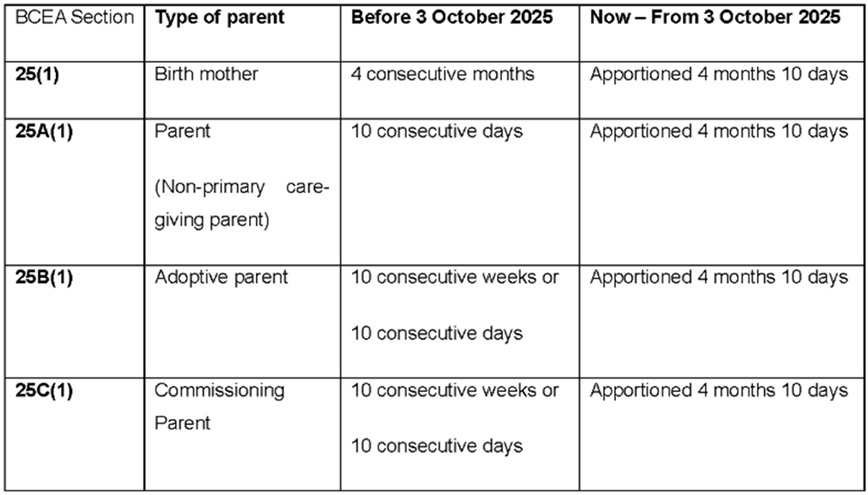Shivani Moodley, Senior Associate | Employment at ENS
In the landmark judgment of Van Wyk & Others v Minister of Employment and Labour, handed down on 3 October 2025, the Constitutional Court unanimously confirmed that the provisions of the Basic Conditions of Employment Act 75 of 1997 (“the BCEA”) and the Unemployment Insurance Act 63 of 2001 (“the UIA”) which regulate maternity, parental, adoption and commissioning parental leave are unconstitutional due to discrimination on a number of listed grounds.
The Court has provided Parliament 36 (thirty-six) months to amend the BCEA and the UIA to remedy the unconstitutionality and unfair discrimination, but has established an interim parental leave regime which shall apply pending legislative amendment. The Court has not established any interim UIF benefits. This is left to Parliament to decide for now, but may be subject to further directions from the Court.
The key principle is that employees should receive equal parental leave benefits regardless of how they became parents (whether through birth, adoption, surrogacy agreement) and regardless of their sex or gender. This is a welcome step towards self-determination and substantive equality in the workplace and in the home.
Interim parental leave benefits
- The concept of “maternity leave” (which only applied to birth mothers) has been removed from the BCEA entirely.
- Both parents are entitled to a total of 4 months and 10 days’ parental leave, the apportionment of which is in the parents’ sole discretion.
- Parents have the sole discretion to determine whether they will take their parental leave entitlement concurrently, consecutively, or partly concurrently and partly consecutively.
- Where the parents do not agree on the apportionment of the parental leave entitlement, the parental leave must be divided between the two of them, as equally as is possible.
- Preference is to be given to birth mothers for the preparation for and recovery from giving birth (This is not provided for in the interim amended legislation provided by the Constitutional Court, but is stated in the judgment. This may, therefore, be of relevance in apportioning the parental leave between the parents).
- If only one of the parents are employed, or if the parent is a single parent, they are entitled to the entirety of the parental leave entitlement.
- This parental leave entitlement also applies to parents who become parents through a surrogacy agreement or if they adopt a child of younger than 2 years of age. Notably, the Court found that the age cap that applies to adopted children is arbitrary and unconstitutional. However, the Court directed Parliament to determine the appropriate age when it amends the legislation in due course.
Comparing the old and the new entitlements

What should employers do?
Employers should conduct a review of their contracts, policies and handbooks to ensure compliance with the new parental leave regime.
Key issues to consider when conducting a review:
- Replace references to “maternity” “adoption” and “commissioning parental leave” with the single reference to “parental leave”.
- Establish sensible procedures for employees to disclose the leave that their partners or co-parents intend to take (for example, letter from the partner/co-parent’s employer or affidavit from the partner/co-parent).
- Provide for birth mothers to take parental leave pre and post-birth.
- Provide for employees who give birth to a still born child or have a miscarriage in the third trimester to take parental leave.
- Establish sensible procedures for employees who become parents by surrogacy agreement or adoption to provide proof of parental rights and responsibilities in terms of the Children’s Act 38 of 2005.
Where parental leave entitlements are regulated by collective agreements: negotiate new collective agreements with the trade union/s if the entitlements are less favourable than that established by the Constitutional Court. In the interim, ensure that parental leave is provided in terms of the new regime, ensuring no differentiation between parents regardless of their gender, sex or how they became parents. This approach should also be applied to parental leave that is regulated by bargaining council collective agreement, pending the conclusion of a new collective agreement in the council.
Commentary
This is a welcome legal development and a step towards creating substantive equality in the workplace and in the home. Employers should carefully consider how they are going to approach the issue going forward, and create a workplace where all parents, regardless of their gender, sex or sexual orientation, are empowered and encouraged to make use of the parental leave entitlements without discrimination.
*Reviewed by Peter le Roux, Executive Consultant in ENS’ Employment Department
ENDS

























































































